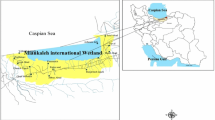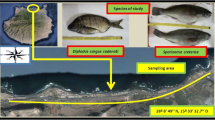Abstract
Multi-element concentrations (Al, As, Cd, Cr, Hg, Ni, Pb, Se, and Sr) were analyzed in the muscle of six fish species (Hoplias malabaricus, Oligosarcus jenynsii, Rhamdia quelen, Bryconamericus iheringii, Astyanax fasciatus, and Odontesthes bonariensis) with different diets and habits from the Río Tercero Reservoir (RTR) in Córdoba, Argentina, during the wet and dry seasons. Besides, potential human health risks, associated with the consumption of these elements, have been assessed considering the average daily intake (EDI) in children and adults. Additionally, the target hazard quotient (THQ) and carcinogenic risk (CR) were evaluated taking into account the intake by the general population, fishermen, and consumption frequency recommended by the American Heart Association (AHA), the maximum scientific reference in cardiology in the USA and worldwide. All species presented quantifiable values in muscle for all the analyzed elements (Al, As, Cr, Hg, Ni, Se, and Sr), except for Cd and Pb, being Al and Sr the most accumulated elements in all species in both seasons. The consumption of edible muscles of the species studied in this reservoir represents a toxicological risk to humans. Mercury and As were the main elements that presented a health risk through the consumption of fish. Their concentrations in most fish species were above the maximum daily allowable concentrations, and THQ values were several times greater than 1. In addition, according to AHA recommendations, the cancer risk caused by As was greater than the acceptable value of 10−4 in all species studied, and in both seasons, with the exception of A. fasciatus, in the rainy season. These results indicate that the consumption of fish from the RTR exposes the inhabitants to possible health risks, especially when considering the consumption frequency recommended by the AHA. Therefore, fish intake from this reservoir should be limited to minimize potential risks to the health of consumers. Finally, the results of this study are useful for controlling pollution and developing preventive and palliative policies to protect populations in contact not only with the reservoir but also with other areas of the world with similar conditions.


Similar content being viewed by others
References
Bardch AE, Ciapponi A, Soto N et al (2015) Epidemiology of chronic disease related to arsenic in Argentina : a systematic review. SciTotal Environ 538:802–816. https://doi.org/10.1016/j.scitotenv.2015.08.070
Basim Y, Khoshnood Z (2013) Target hazard quotient evaluation of cadmium and lead in fish from Caspian Sea. Toxicol Ind Health 1–6. https://doi.org/10.1177/0748233713498451
Benson R, Conerly OD, Sander W, Batt AL, Boone JS, Furlong ET, Glassmeyer ST, Kolpin DW, Mash HE, Schenck KM, Simmons JE (2017) Human health screening and public health significance of contaminants of emerging concern detected in public water supplies. Sci Total Environ 579:1643–1648. https://doi.org/10.1016/j.scitotenv.2016.03.146
Bergés-Tiznado ME, Márquez-Farías JF, Torres-Rojas Y et al (2015) Mercury and selenium in tissues and stomach contents of the migratory sailfish, Istiophorus platypterus, from the Eastern Pacific: concentration, biomagnification, and dietary intake. Mar Pollut Bull 101:349–358. https://doi.org/10.1016/j.marpolbul.2015.10.021
Bertolotti MI, Errazti E, Pagani AN (1996) La comercialización de productos pesqueros. Promoción del consumo de pescado en el mercado interno. FACES 2:7–25 ISSN 0328-4050
Bloom NS (1992) On the chemical form of mercury in edible fish and marine invertebrate tissue. Can J Fish Aquat Sci 49:1010–1017. https://doi.org/10.1139/f92-113
Bundschuh A, Pérez Carrera M, Litter MI (2008) Distribución del arsénico en la región Ibérica e Iberoamericana. Desarrollo EPIdCyTpe, Litter
Cappon C, Smith J (1982) Chemical form and distribution of mercury and selenium in edible seafood. J Anal Toxicol 6:10–21. https://doi.org/10.1093/jat/6.1.10
Copat C, Bella F, Castaing M, Fallico R, Sciacca S, Ferrante M (2012) Heavy metals concentrations in fish from Sicily (Mediterranean Sea) and evaluation of possible health risks to consumers. Bull Environ Contam Toxicol 88:78–83. https://doi.org/10.1007/s00128-011-0433-6
Di Rienzo JA, Casanoves F, Balzarini MG, et al (2013) InfoStat versión, 2013. Grupo InfoStat. FCA, Universidad Nacional de Córdoba, Argentina
Dipas and UNC (2007) Estudio de contaminación del Río Tercero (Ctalamochita) y control de vertidos. Primer Informe
Fallah AA, Saei-dehkordi SS, Nematollahi A, Jafari T (2011) Comparative study of heavy metal and trace element accumulation in edible tissues of farmed and wild rainbow trout (Oncorhynchus mykiss) using ICP-OES technique. Microchem J 98:275–279. https://doi.org/10.1016/j.microc.2011.02.007
FAO. Food and Agriculture Organization of the United Nations. (2018) http://www.fao.org/3/i9540en/i9540en.pdf
Garnero PL, Monferran MV, González GA, Griboff J, de Los Ángeles BM (2018) Assessment of exposure to metals, As and Se in water and sediment of a freshwater reservoir and their bioaccumulation in fish species of different feeding and habitat preferences. Ecotoxicol Environ Saf 163:492–501. https://doi.org/10.1016/j.ecoenv.2018.07.023
Graeme KA, Pollack CV (1998) Heavy metal toxicity, part I: arsenic and mercury. J Emerg Med 16:45–56
Griboff J, Wunderlin DA, Monferran MV (2017) Metals, As and Se determination by inductively coupled plasma-mass spectrometry (ICP-MS) in edible fish collected from three eutrophic reservoirs. Their consumption represents a risk for human health? Microchem J 130:236–244. https://doi.org/10.1016/j.microc.2016.09.013
Hallenbeck WH (1993) Quantitative risk assessment for environmental and occupational health
Harguinteguy CA, Schreiber R, Pignata ML (2013) Myriophyllum aquaticum as a biomonitor of water heavy metal input related to agricultural activities in the Xanaes River (Córdoba, Argentina). Ecol Indic 27:8–16. https://doi.org/10.1016/j.ecolind.2012.11.018
Haro JG, Bistoni MA (2007) “Peces de Córdoba” 1a ed. Ed. Universidad Nacional de Córdoba. 178-183
Heshmati A, Karami-Momtaz J, Nili-Ahmadabadi A, Ghadimi S (2017) Dietary exposure to toxic and essential trace elements by consumption of wild and farmed carp (Cyprinus carpio) and Caspian kutum (Rutilus frisii kutum) in Iran. Chemosphere 173:207–215
IARC (International Agency for Research on Cancer) (1993) IARC monographs on the evaluation of carcinogenic risks to humans. Vol 58. Beryllium, cadmium, mercury, and exposures in the glass manufacturing industry
Jabeen F, Chaudhry A (2010) Environmental impacts of anthropogenic activities on the mineral uptake in Oreochromis mossambicus from Indus River in Pakistan. Environ Monit Assess 166:641–651. https://doi.org/10.1007/s10661-009-1029-z
Jinadasa BKKK, Fowler SW (2019) Critical review of mercury contamination in Sri Lankan fish and aquatic products. Mar Pollut Bull 149:110526. https://doi.org/10.1016/j.marpolbul.2019.110526
Kris-Etherton PM, Harris WS, Appel LJ (2002) Fish consumption, fish oil, omega-3 fatty acids, and cardiovascular disease. Circulation 106:2747–2757. https://doi.org/10.1161/01.CIR.0000038493.65177.94
Mancini M, Grosman F (1998) Aspectos poblacionales del pejerrey Odontesthes bonariensis en el Embalse Río Tercero, Córdoba. Natura Neotropicalis 29:137–143
Mariazzi AA, Donadelli JL, Arenas P et al (1992) Impact of a nuclear power plant on water quality of Embalse del Rio Tercero Reservoir, (Cordoba, Argentina). Hydrobiologia 246:129–140
Mariñelarena A, Donadelli J, Hechem M (2014) Cambios en las características limnológicas del Embalse Río Tercero por efecto de la invasión de Limnosperma fortunei (Bivalvia: Mytilidae). Biología Acuática 30:151–158
Mason RP, Choi AL, Fitzgerald WF, Hammerschmidt CR, Lamborg CH, Soerensen AL, Sunderland EM (2012) Mercury biogeochemical cycling in the ocean and policy implications. Environ Res 119:101–117. https://doi.org/10.1016/j.envres.2012.03.013
Moallem SA, Karimi G, Khayyat MH et al (2010) Exposure assessment for mercury from consumption of marine fish in Iran. Toxicol Environ Chem 92:1213–1218. https://doi.org/10.1080/02772240903233595
Monferran MV, Garnero PL, Wunderlin DA, de la Bistoni M (2016) Potential human health risks from metals and As via Odontesthes bonariensis consumption and ecological risk assessments in a eutrophic lake. Ecotoxicol Environ Saf 129:302–310. https://doi.org/10.1016/j.ecoenv.2016.03.030
Moreno-Sánchez R, Díaz-Barriga F, Devars S (1999) Mecanismos de toxicidad y tolerancia a los metales pesados. Contaminación ambiental por metales pesados. Impacto en los seres vivos
MyTran TA, Leermakers M, Long T, et al (2018) Metals and arsenic in sediment and fi sh from Cau Hai lagoon in Vietnam : Ecological and human health risks. Chemosphere 210:175–182. https://doi.org/10.1016/j.chemosphere.2018.07.002
Nawab J, Khan S, Xiaoping W (2018) Ecological and health risk assessment of potentially toxic elements in the major rivers of Pakistan : general population vs. fishermen. Chemosphere 202:154–164. https://doi.org/10.1016/j.chemosphere.2018.03.082
PNUMA. UNITED NATIONS ENVIRONMENTAL PROGRAMME (2005) GLOBAL MERCURY ASSESSMENT
Sevillano-Morales JS, Cejudo-Gómez M, Ramírez-Ojeda AM et al (2015) Risk profile of methylmercury in seafood. Curr Opin Food Sci 6:53–60. https://doi.org/10.1016/j.cofs.2016.01.003
Tao Y, Yuan Z, Xiaona H, Wei M (2012) Distribution and bioaccumulation of heavy metals in aquatic organisms of different trophic levels and potential health risk assessment from Taihu lake, China. Ecotoxicol Environ Saf 81:55–64. https://doi.org/10.1016/j.ecoenv.2012.04.014
USEPA (US Environmental Protection Agency). (1989). Risk assessment guidance for superfund. In: Human Health Evaluation Manual Part A, Interim Final, vol. I. United States Environmental Protection Agency. Washington DC. EPA/540/1–89/ 002
USEPA (US Environmental Protection Agency) (1991). Technical Support Document For Water Quality-based Toxics Control. Washington DC. EPA/505/2–90-001
USEPA (US Environmental Protection Agency) (2000). Risk-based concentration table. United States Environmental Protection Agency. Philadelphia PA, Washington DC
USEPA (US Environmental Protection Agency) (2010). Risk-based concentration table. Disponible online: http://www.epa.gov/reg3hwmd/risk/human/index.htm
USEPA (US Environmental Protection Agency)(2017). Human health risk assessment. Regional Screening Level (RSL) Summary Table. Disponible online:https://www.epa.gov/risk/regionalscreening-levels-rsls-generic-tables-june-2017
Wang X, Wang WX (2019) The three “B” of fish mercury in China: bioaccumulation, biodynamics and biotransformation. Environ Pollut 250:216–232. https://doi.org/10.1016/j.envpol.2019.04.034
Yi Y, Yang Z, Zhang S (2011) Ecological risk assessment of heavy metals in sediment and human health risk assessment of heavy metals in fishes in the middle and lower reaches of the Yangtze River basin. Environ Pollut 159:2575–2585. https://doi.org/10.1016/j.envpol.2011.06.011
Yi Y, Tang C, Yi T, Yang Z, Zhang S (2017) Health risk assessment of heavy metals in fish and accumulation patterns in food web in the upper Yangtze River, China. Ecotoxicol Environ Saf 145:295–302. https://doi.org/10.1016/j.ecoenv.2017.07.022
Yun-Ru J, Chen CW, Chen CF et al (2017) Assessment of heavy metals in aquaculture fishes collected from southwest coast of Taiwan and human consumption risk. Int Biodeterior Biodegrad 124:314–325. https://doi.org/10.1016/j.ibiod.2017.04.003
Zhuang P, McBride MB, Xia H, Li N, Li Z (2009) Health risk from heavy metals via consumption of food crops in the vicinity of Dabaoshan mine, South China. Sci Total Environ 407:1551–1561. https://doi.org/10.1016/j.scitotenv.2008.10.061
Acknowledgments
The authors thank the National Scientific and Technical Research Council (CONICET, PIP 112-201101-01084) 461 and the Science and Technology Office (SECYT, 2014–2015. Res no. 203/14) of the National University of Córdoba (Argentina) for grants and subsidies. We also thank Joaquín Gastaminza for his help during sample measurement with the ICP-MS.
Author information
Authors and Affiliations
Corresponding author
Additional information
Responsible editor: Philippe Garrigues
Publisher’s note
Springer Nature remains neutral with regard to jurisdictional claims in published maps and institutional affiliations.
Electronic supplementary material
ESM 1
(DOC 91 kb)
Rights and permissions
About this article
Cite this article
Garnero, P.L., Bistoni, M.d. & Monferran, M.V. Trace element concentrations in six fish species from freshwater lentic environments and evaluation of possible health risks according to international standards of consumption. Environ Sci Pollut Res 27, 27598–27608 (2020). https://doi.org/10.1007/s11356-020-08756-7
Received:
Accepted:
Published:
Issue Date:
DOI: https://doi.org/10.1007/s11356-020-08756-7




